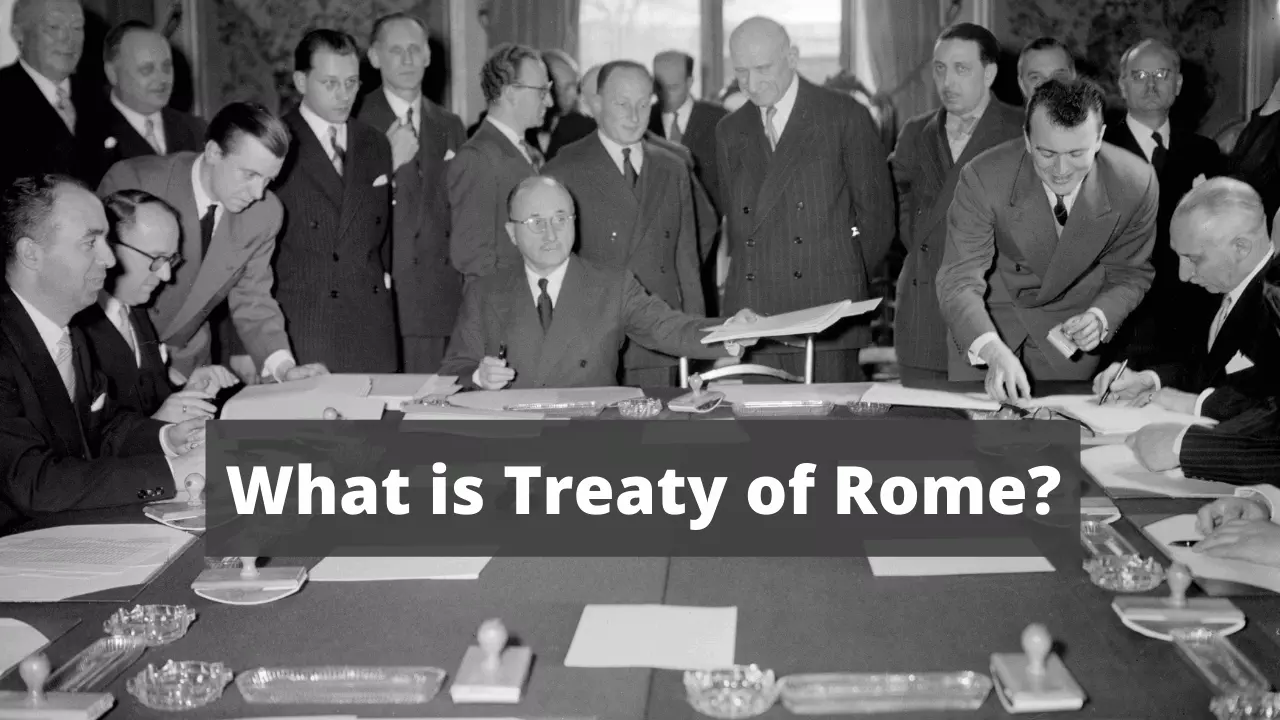
Treaty of Rome 1957
The Treaty of Rome (1957)
On March 25, 1957, Germany, Belgium, France, Italy, Luxembourg and the Netherlands signed two treaties in Rome:
- the first created the European Economic Community (EEC) ;
- The second created the European Atomic Energy Community (EAEC or Euratom).
These two treaties entered into force on January 14, 1958. The new Communities then appeared as a factor of economic strengthening for the Member States.
The mission of the EEC , through the establishment of a common market and the progressive approximation of the economic policies of the Member States, is to promote a harmonious development of economic activities throughout the Community, a continuous and balanced expansion, increased, accelerated rise in living standards, and closer relations between the states that it brings together.
Read- Unification of Italy #UPSC
Taking as its basis the ECSC Treaty of 1951, the Treaty of Rome widens the scope of supranational cooperation and thus relaunches European construction, slowed down by the failure, in 1954, of the political project of a European Defense Community (EDC). The economic field, less subject to national resistance, appears to be a consensual field of cooperation.
The Euratom Community is of a different nature. It is not a question of pooling already existing economic activities, but of contributing to the formation and growth of a European nuclear industry. This Community still exists.
The European Economic Community
In the preamble to the treaty, the member states declare:
- “ [To be] determined to lay the foundations for an ever closer union between the peoples of Europe;
- [be] determined to ensure, through common action, the economic and social progress of their countries by eliminating the barriers which divide Europe;
- have as its essential aim the constant improvement of the living and employment conditions of their peoples;
- recognize that the removal of existing obstacles calls for concerted action to ensure stability in expansion, balance in trade and fairness in competition;
- [be] anxious to strengthen the unity of their economies and ensure their harmonious development, by reducing the gap between the different regions and the backwardness of the less favored;
- [be] willing to contribute, through a common commercial policy, to the gradual removal of restrictions on international trade;
- want to confirm the solidarity which binds Europe and the overseas countries, and ensure the development of their prosperity, in accordance with the principles of the United Nations Charter;
- [to be] resolved to strengthen, through the constitution of this set of resources, the safeguards of peace and freedom, and to call [er] the other peoples of Europe who share their ideals to join in their effort ”.
Free movement and common policies
The common market implies a customs union between the member states, i.e. the elimination of customs duties and quotas for the goods they trade, as well as the establishment of a trade policy and a common customs tariff with regard to third States. A 12-year transition period is then foreseen.
As the market is based on the principle of free competition, the treaty prohibits agreements between companies, as well as State aid (except those of a social nature). In addition to the free movement of goods, the Single Market also provides for “ the abolition, between Member States, of obstacles to the free movement of persons, services and capital ” .
Its operation requires the approximation of national laws and the development of common policies. The Treaty provides for the establishment of common policies not only in the field of trade and competition, but also in those of transport and agriculture.
The departments (DOM) and overseas territories (OCTs) are associated with the common market with the aim of increasing trade and jointly pursuing the effort of economic and social development.
Read- Fourth Industrial Revolution #UPSC
A new institutional system
So, five in number, the institutions of the EEC still exist today:
- the European Commission
- the Council of Ministers
- the European Parliament
- the court of Justice
- the Economic and Social Council
The EEC and the Euratom Community are less overtly supranational than the ECSC. They are thus perceived as less threatening to respect for national sovereignties. The Treaty of Rome thus sets up institutions and decision-making mechanisms allowing the expression of both national interests and a community vision.
An executive independent from national governments is created: the European Commission , which has exclusive right of initiative.
Unlike what the ECSC Treaty provides, most of the decision-making powers are held by the Council of Ministers , made up of government representatives. It is an intergovernmental body which decides either by qualified majority or unanimously.
In 1965, with the Merger Treaty, the Council and the Commission became institutions common to the three Communities (ECSC, EEC, Euratom). The European Parliament originally had only a consultative power and it was not until 1976 that its election by direct universal suffrage was decided, the first of which was to take place in 1979.
The Court of Justice , established in 1952, ensures compliance with Community law in the application and interpretation of treaties.
An Economic and Social Council is based on the French model to give an advisory opinion on the projects submitted to it.
The treaty provides for the creation of the ESF , the European Social Fund, with a view to improving the employment opportunities of workers and contributing to raising their standard of living; and the EIB , European Investment Bank, intended to facilitate the economic expansion of the Community by creating new resources.
Application of the treaty and its modifications
The effects of customs dismantling and the abolition of quantitative restrictions on trade during the transition period (1958-1970) are spectacular: intra-community trade is multiplied by 6, while the EEC's trade with third countries is multiplied by 3 The average GNP increased by 70%. But obstacles in the form of various regulations continue to weigh on free movement.
The signature of the Single European Act in 1986 fixes the completion of the internal market on January 1, 1993.
With the Maastricht Treaty signed in 1992, the European Union was created: European cooperation was strengthened in new political areas and the decision was taken to adopt a single currency.
The Treaty of Amsterdam (1999) and the Treaty of Nice (2001) will then extend the development of the Union and seek to adapt its institutional system in view of future enlargements.
After the rejection of the Treaty establishing a Constitution for Europe (TECE) in 2005, the Treaty of Lisbon (2009) profoundly adapted the rules of the old treaties to allow better coordination among 27 member states.
Related Articales
Recently Posted
-
भगवान गौतम बुद्ध जीवन परिचय | Gautam Buddha in Hindi
December 15, 2022. -
कार्बन के अपररूप Allotropes of Carbon in Hindi
November 5, 2022. -
मिश्र धातु किसे कहते हैं? उपयोग, नाम, गुण Alloy in Hindi
July 27, 2022. -
गलनांक किसे कहते हैं? परिभाषा, उदाहरण Melting Point in Hindi
July 20, 2022. -
परिमाप किसे कहते हैं? Perimeter in Hindi
July 19, 2022.




